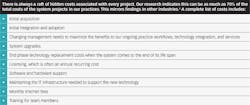Managing the true cost of digital dentistry and technology ownership in our practices
Digital dentistry impacts all of us. Dr. Gary Kaye says it is important to know the total cost of ownership of the technology in your practice, so you understand exactly how it affects your bottom line and can anticipate any hidden costs.
I suspect that more than two-thirds of the readers of this article are involved, in some way, in acquiring new equipment and services for their dental practices. The digital dentistry revolution impacts all of us! However, shallow thinking, tight budgets, and limited expertise very often keep us from making effective IT decisions. The brutal reality is that many technology projects fail to achieve the intended results and return on investment.
It has been my experience that as we introduce different technologies to the practice, not only is it important to bring in the right technology, but it is also important to know the total cost of ownership of that technology.
One of the major mistakes is to believe that our costs end at the point of purchase. We often fail to scrutinize the costs over the life cycle of the equipment. Research indicates that initial purchase is just a fraction of the total cost of ownership. For example, a $1,000 PC may actually cost three or four times that over its life cycle, once you factor in the costs of software, extended warrantees, firewalls, storage servers, routers, printers, internet connectivity, repairs, upgrades, etc.
The total cost of ownership (TCO) concept attempts to assess the complete, holistic, direct, and indirect costs across the lifetime of a technology project. We often underestimate and undermanage the true costs of technology ownership as we get caught up in the exhilaration about the new possibilities of caring for our patients and improving our professional skills.
There are three types of costs where detailed, vigilant management is required: financial, time, and energy. Better understanding of the total costs associated with new technology helps us to make better decisions about which technology solutions/vendors to bring in, budget better, and avoid the negative cycle of unanticipated consequences, hidden costs, and frustrated strategies (table 1).
Great ideas and vision are worthless if they can’t be implemented rapidly and efficiently. Good leaders pay attention to the details every day, and challenge themselves and their teams to constantly appraise the reality of the implementation. Staff training on new equipment is notoriously hard, and we struggle to get team members up on the learning curve to the appropriate levels. Everyone has his or her individual “best” way of learning, and we all start from different technology baselines. Some are supertechs; some are technophobic! Sometimes team members even actively or passively resist new technology, workflow, and role changes ... and each of these situations needs to be managed effectively to help the team develop the know-how and experience to bring various projects to a successful implementation.
Difficult interactions and poor integration of different systems can also present real headaches and cost. For example, user frustration, troubleshooting, and downtime can affect productivity and contribute to loss of revenue. Upgrades for hardware and software are another underestimated, recurrent management challenge; there are real staff-related costs associated with managing this as well. Some vendors do a great job of supporting their system upgrades. Seek out those vendors, as the cost of inefficiency falls directly onto the practice!
Every practice owner today is confronted by the real threat of any extraneous event that comes along and interrupts the ability to operate as usual. The more we invest in technology, the greater the importance becomes of having effective disaster recovery and business continuity arrangements. And with this, we are faced with new hidden costs of creating appropriate business continuity assurance. We all know the debilitating costs and impact of Internet or telephone downtime in our practices.
Managing the TCO of technology requires significant time. I have written extensively in this column and elsewhere about the team’s role in integrating new technologies into the practice. We need to ensure that managers and teams have the necessary time scheduled to devote to technology projects so that they are supported appropriately. All too often practices wing it with regard to appropriate staff scheduling and time management.
More than time, I believe that we must also ensure that everyone brings the right energy to technological projects. Setting aside appropriate time when we are not exhausted or overwhelmed by the events of the day will help us to produce the required quality of learning, coordination, integration, and project results.
For each technology project, we must carefully count the costs so that we expend the right money, time, and energy on high-quality implementation. Remember, it costs a lot more to manage badly implemented technology projects and environments in our practices!
Reference
1. Understanding technology costs. Network Alliance website. http://www.networkalliance.com/your-advantage/understanding-technology-costs. Accessed March 6, 2017.
Gary Kaye, DDS, FAGD, founder of the New York Center for Digital Dentistry, has practiced comprehensive dentistry in New York City since 1993. He graduated from Columbia University of Dental Medicine in 1993, where he received awards in endodontics, prosthodontics, and geriatric dentistry. Dr. Kaye consults with other dentists and dental manufacturers and lectures on topics including ceramics, occlusion, and digital dentistry. He is on the guest faculty of Planmeca University in Dallas, Texas.
About the Author
Gary Kaye, DDS, FAGD
Founder, New York Center for Digital Dentistry
Gary Kaye, DDS, FAGD, founder of the New York Center for Digital Dentistry, has practiced comprehensive dentistry in New York City since 1993. He graduated from Columbia University of Dental Medicine in 1993, where he received awards in endodontics, prosthodontics, and geriatric dentistry. Dr. Kaye consults with other dentists and dental manufacturers and lectures on topics including ceramics, occlusion, and digital dentistry. He is on the guest faculty of Planmeca University in Dallas, Texas.
Bio updated April 21, 2017

